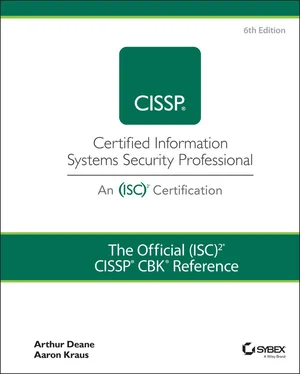Countermeasure Selection and Implementation
Mitigation is the most common risk treatment method of the four treatment approaches in the previous section. Risk mitigation involves the selection and implementation of one or more countermeasures (or “security controls”) with the goal of reducing the likelihood of an adverse event or the impact of that event occurring. Countermeasures generally fall into three categories:
Personnel-related: As people are commonly considered to be an organization's “weakest link,” these countermeasures often prove invaluable. Hiring (or firing), organization restructuring, and awareness training are some common personnel-related countermeasures. Despite our potential as weaknesses, people in high-performing organizations with strong security awareness programs can often prove to be the greatest security asset.
Process-related: Policy, procedure, and other “workflow-based” mitigations generally fall into this category. As an example, consider the implementation of separation of duties on invoice approval and payment as a process-related mitigation against cyber fraud.
Technology-related: This is the category that typically gets the most attention. Encryption, modifying configuration settings, and other hardware or software changes are common examples of technology-related countermeasures.
When selecting countermeasures, you must consider factors such as security-effectiveness, cost-effectiveness, and operational impact.
Measuring the security-effectiveness of a security control is an essential step in the selection and implementation process. When selecting your countermeasures, you want to be certain that the specific policy, technology, or operational control that you select is able to directly address a risk identified during your risk analysis process. To do this, one must consider what kind of security risks one wants to prevent, detect, or correct, and then identify countermeasures that specifically target those risks. For example, many security teams choose to throw encryption at everything, but if you are concerned with risks that encryption cannot fix (like availability risks), you are better off using those resources for other countermeasures (such as backups).
Perhaps even more important than security-effectiveness (believe it or not), cost-effectiveness is a primary consideration for security teams and the management teams that oversee them. Cost-effectiveness can be calculated by performing a cost-benefit analysis that compares the cost of a countermeasure (or multiple countermeasures) to the costs that would be realized by a compromise of the risks that the countermeasures are intended to mitigate.
A countermeasure can be considered cost-effective if the annual loss expectancy (ALE) with the countermeasure plus the cost of countermeasure is less than ALE without the countermeasure. For example, if the ALE associated with theft of sensitive data is $500,000, you can theoretically spend up to $499,999.99 on countermeasures to reduce the ALE of such data theft to $0.01. Of course, you'd want to gain more than a single penny from all your troubles, but this demonstrates the point. Another way to look at it is if the ALE due to ransomware attacks on your company is projected at $200,000 and you spend $50,000 on a sophisticated backup system, the selected countermeasure has a value of $150,000 to your organization, which is quite clearly cost-effective.
NOTECountermeasures generally have an initial acquisition and implementation cost, followed by recurring (e.g., annual) operating and maintenance costs. You should consider both sets of costs when determining whether a countermeasure makes financial sense for your organization.
Beyond cost-effectiveness and pure security-effectiveness, you must be sure to evaluate the potential operational impact that a countermeasure may have on your organization. If a countermeasure is too difficult to implement or use, it may have a counterintuitive effect and actually increase risk because it is not being used properly (or at all). For example, some organizations require the use of third-party email encryption platforms to send sensitive information, and some of these platforms are not user friendly at all. Without careful selection of a platform and proper user training, some users may circumvent this countermeasure and send sensitive emails in the clear. Understanding your organization's culture and strategy is an important part of selecting countermeasures that don't have a negative operational impact.
Applicable Types of Controls
A security control is any safeguard that is put in place to positively impact security. Security controls may be automatic or manual, and they can be technical (i.e., implemented and executed through hardware, software, or firmware), operational (i.e., related to day-to-day operations and tangible things like security guards, gates, etc.), or management (i.e., implemented by people and related to administrative methods — things like policies, procedures, and guidelines). There are five major types of controls, and you'll notice that some countermeasures (like security guards) may fit into multiple categories:
Preventative: These are the first-line controls that are designed to keep adverse security events from occurring. For example, software applications typically have some form of “input validation” to avoid invalid inputs from being executed and causing an issue. Firewalls, system backups, and security awareness training are other common examples of preventative controls.
Detective: These controls are designed to identify a negative security event while it is in progress or soon after it occurs. Much like a human detective, this type of control is intended to gather information and help security teams determine what happened, how bad the damage is, and what caused it to happen. Security audits, door alarms, and IDSs are common examples of detective controls.
Corrective: These controls are designed to minimize and repair damages following an adverse security event; they are typically put in place after a detective control identifies a problem. Corrective controls include things such as software patches, configuration file modifications, and new policies that target the cause of the incident.
Recovery: These countermeasures are designed to complement corrective controls, with the intent to get a system back to normal as quickly as possible. Examples include system and data backups and disaster recovery sites.
Deterrent: These controls are designed to discourage attackers by making them think twice about their malicious intents. Wired fences, security guards, and guard dogs are some examples of deterrents.
TIPYou should also be familiar with the concept of a compensating control , which is a safeguard used in addition to or in place of a primary control; compensating controls are often implemented if a primary control cannot be fully implemented for some reason. For example, if a technical security control is too expensive, you may opt for policies that encourage rather than enforce a desired behavior. The compensating control may not fully mitigate the risk, but it provides some level of security that wouldn't exist without any control being implemented. PCI-DSS provides some good examples of compensating controls usage.
Periodic assessment of your security controls is equally as important as the selection and implementation of those controls. In many cases, your organization may have legal or regulatory requirements that dictate how and when to conduct security control assessments (SCA), but in all cases, you should routinely conduct control assessments to ensure that your security and privacy controls remain effective.
Читать дальше












